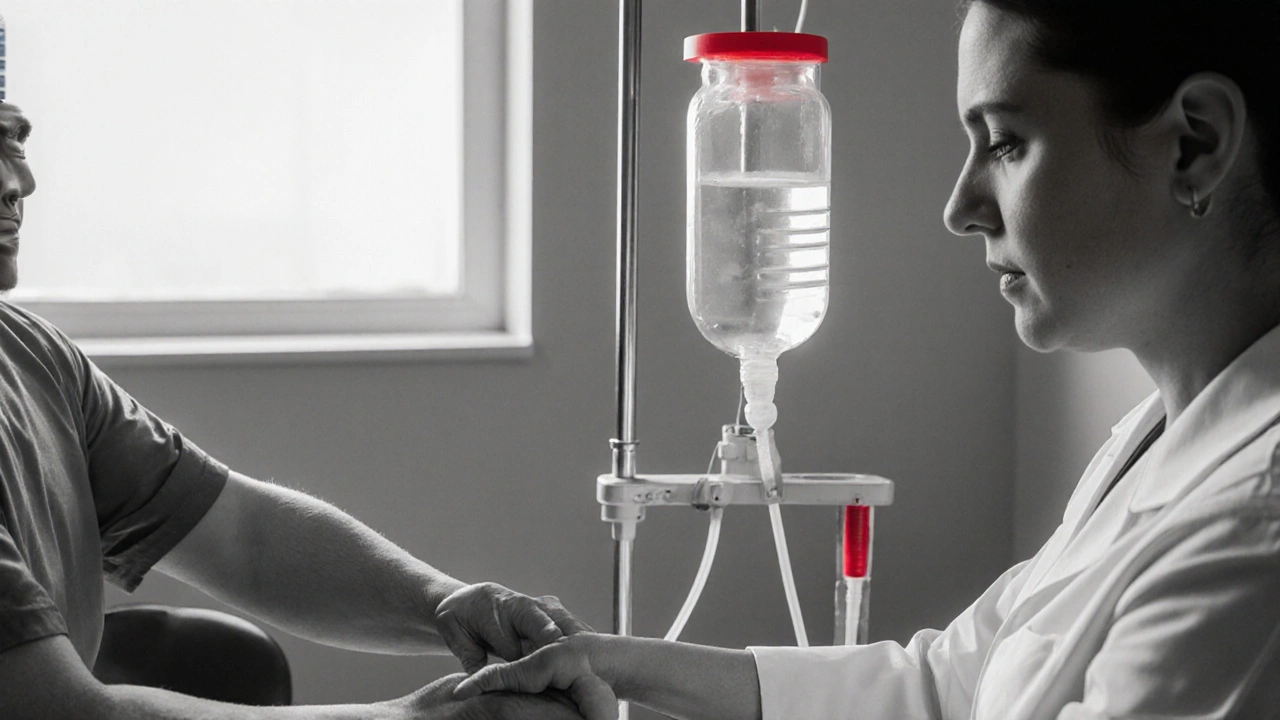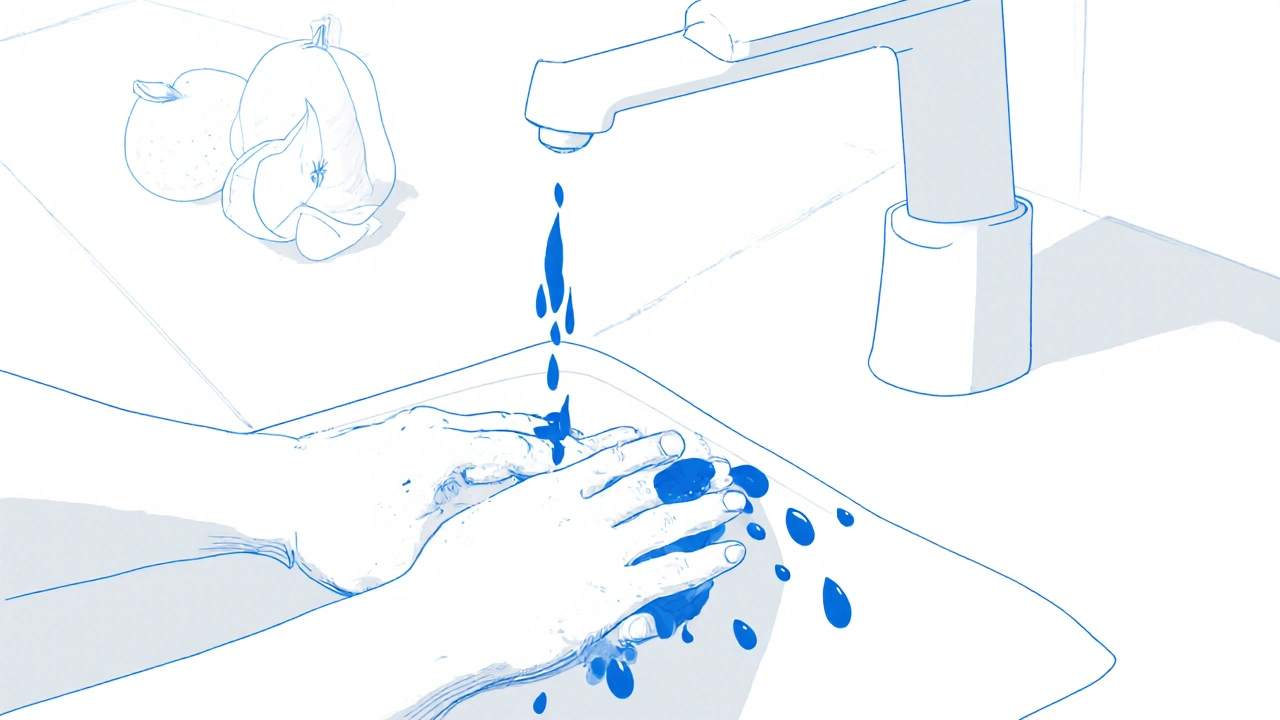Acute Diarrhea Symptom Checker
This tool helps you assess whether your acute diarrhea symptoms require medical attention based on guidelines from the article. Check all symptoms you're experiencing.
Key Takeaways
- Acute diarrhea usually lasts under two weeks and is often caused by infections or food‑borne toxins.
- Seek medical help if you have high fever, blood in stool, severe dehydration, or symptoms lasting more than a few days.
- During the visit the doctor will assess dehydration, order stool tests if needed, and may prescribe rehydration fluids or targeted medication.
- While waiting for the appointment, stay hydrated with oral rehydration solutions and avoid dairy, caffeine, and high‑fat foods.
- Prevent future episodes by practicing good hand hygiene and being cautious with food and water while traveling.
Acute Diarrhea is a sudden surge of loose stools that typically resolves within two weeks. It differs from chronic diarrhea, which persists longer and may signal an underlying condition.
Most cases stem from gastroenteritis, a viral or bacterial infection that inflames the gut lining. Common culprits include norovirus, rotavirus, food poisoning from contaminated meat or shellfish, and traveler's diarrhea caused by unfamiliar bacteria in water or food.
When the body fights the infection, it increases fluid secretion and speeds up intestinal movement, leading to watery stool and loss of electrolytes. If you notice acute diarrhea, you’ll want to know whether it’s a short‑lived upset or something that needs professional care.
Typical Course and When It Escalates
For most healthy adults, symptoms peak within 24‑48hours and gradually improve. However, certain signs signal that the condition is moving beyond a simple upset stomach. Watch for these red‑flag symptoms:
| Red‑Flag Symptom | Why It Matters | Typical Acute Diarrhea |
|---|---|---|
| Fever≥38.5°C (101.3°F) | Suggests bacterial infection or systemic involvement | Low‑grade or no fever |
| Blood or mucus in stool | May indicate invasive bacteria (e.g., Shigella, E.coli) | Clear, watery stool |
| Signs of dehydration (dry mouth, dizziness, reduced urine output) | Electrolyte loss can become dangerous quickly | Mild fluid loss, normal urination |
| Duration >3days without improvement | Increases risk of complications | Improvement after 1‑2days |
| Severe abdominal pain or persistent vomiting | May signal obstruction or severe infection | Crampy but tolerable pain |

What Happens at the Doctor’s Office
The first step is a quick assessment of hydration status. The clinician will check skin turgor, mucous membranes, pulse, and may weigh you to spot fluid loss. If dehydration is moderate to severe, you might receive intravenous (IV) fluids on the spot.
Next, the doctor will ask about recent travel, diet, medication use, and any exposure to sick contacts. This history helps narrow down the likely cause-viral, bacterial, or parasitic.
Diagnostic tests are not always needed, but common ones include:
- Stool culture to detect pathogenic bacteria.
- Fecal leukocyte or occult blood test if blood is present.
- Rapid antigen test for Clostridioides difficile when recent antibiotics are a factor.
Based on findings, treatment may involve:
- Rehydration-either oral Oral Rehydration Solution (ORS) or IV fluids.
- Antimicrobial therapy if a specific bacterial pathogen is identified (e.g., antibiotic therapy for Campylobacter).
- Symptomatic relief with anti‑diarrheal agents, but only if infection is ruled out and dehydration is not a risk.
Self‑Care While You Wait for the Appointment
Hydration is the cornerstone. Aim for 150‑200ml of ORS every hour if you’re losing fluids rapidly. Commercial ORS packets are inexpensive and well‑balanced; you can also make a homemade version with 1liter of clean water, 6teaspoons of sugar, and half a teaspoon of salt.
Eat bland, easy‑to‑digest foods such as toast, bananas, rice, and applesauce-the classic “BRAT” diet. Avoid dairy, caffeine, alcohol, and high‑fat meals, which can worsen stool frequency.
If you have mild fever, acetaminophen can help, but steer clear of NSAIDs like ibuprofen if you suspect a bacterial infection that might irritate the stomach lining.

Follow‑Up and When to Return
Most patients feel better within 48hours after rehydration and supportive care. If symptoms persist beyond three days, worsen, or new red‑flag signs appear, contact your GP again or go to urgent care.
For children, the elderly, or people with chronic illnesses (e.g., diabetes, heart disease), seek medical advice sooner-dehydration can develop faster and have more severe consequences.
Prevention Tips to Lower Future Risks
- Wash hands thoroughly with soap and water for at least 20seconds, especially after using the toilet and before handling food.
- Cook meats to safe internal temperatures (e.g., 75°C/165°F for poultry).
- Wash fruits and vegetables under running water; peel if you’re unsure of the source.
- When traveling, drink bottled or boiled water, avoid ice cubes, and eat only hot‑cooked meals.
- Consider probiotic‑rich foods (yogurt, kefir) to support a healthy gut microbiome.
Frequently Asked Questions
How long should acute diarrhea last before I worry?
If the stools are still watery after 72hours, or if you develop fever, blood, or signs of dehydration, it’s time to see a doctor.
Can I take anti‑diarrheal medicine at home?
Only if a health professional confirms you don’t have a bacterial infection and you’re not dehydrated. Loperamide can slow gut movement but may trap harmful pathogens.
Is it safe to drink sports drinks for rehydration?
Sports drinks contain sugar and electrolytes but often not enough sodium for severe diarrhea. ORS is a better choice; if unavailable, dilute a sports drink with water (1 part drink to 2 parts water).
When is antibiotic treatment recommended?
If stool tests identify a bacterial pathogen like Shigella, Campylobacter, or certain strains of E.coli, a short course of antibiotics may be prescribed. Otherwise, most cases resolve without them.
Should children with diarrhea see a pediatrician immediately?
Yes, especially for infants under 12months. They can become dehydrated quickly, so a pediatrician should assess them early.

14 Responses
Great, another guide that tells you to drink water like a camel.
The article provides a comprehensive overview of acute diarrhea, delineating both common etiologies and red‑flag symptoms with commendable clarity. It correctly emphasizes the importance of early detection of high fever, hematochezia, and dehydration, which are pivotal for clinical decision‑making. Moreover, the recommendation to monitor symptom duration beyond three days aligns with established gastroenterological guidelines. The inclusion of a step‑by‑step diagnostic algorithm is especially beneficial for primary care practitioners who may encounter such cases sporadically. The description of rehydration strategies, both oral and intravenous, reflects current best practices and underscores the necessity of electrolyte balance. I appreciate the nuanced discussion regarding the cautious use of anti‑diarrheal agents, noting that they should be avoided in the presence of invasive pathogens. The preventive measures enumerated, such as hand hygiene and safe food handling, are appropriately highlighted for public health education. Additionally, the article’s structure, with distinct sections and tables, facilitates quick reference during patient encounters. The use of medical terminology is precise, yet the explanations remain accessible to a lay audience. The advice against NSAIDs in bacterial infections is a subtle yet crucial point that many resources overlook. The brief mention of probiotic supplementation as a supportive measure is evidence‑based and timely. It is also noteworthy that the article references specific pathogenic organisms, guiding clinicians toward targeted antimicrobial therapy when indicated. The discussion on pediatric considerations is thorough, stressing the heightened risk of rapid dehydration in infants. Overall, the piece serves as a valuable tool for both clinicians and patients navigating the complexities of acute diarrheal illness. Finally, the integration of an interactive symptom checker enhances user engagement and promotes self‑assessment, a forward‑thinking addition to traditional health articles.
Yo, thanks for the solid rundown! The red‑flag list is super useful – especially the part about blood in stool, that’s a real alarm. I love the practical tips on ORS; makin’ it at home is a game‑changer. Keep dropping these gems, they’re real lifesavers.
Reading this made me ponder the deeper interplay between our gut flora and modern lifestyle. While the article focuses on acute episodes, it subtly hints at the long‑term consequences of repeated dysbiosis. One could argue that habitual stress and poor diet prime our intestines for such flare‑ups. The emphasis on hand hygiene, though simple, reflects a profound respect for microbial ecosystems. Let us not forget that prevention begins with mindfulness toward what we ingest and how we cleanse.
This guide is both culturally sensitive and medically rigorous. It acknowledges diverse dietary practices while presenting universal health advice. The section on travel‑related diarrhea adeptly balances caution with encouragement for global exploration. By citing specific pathogens, the article respects readers’ desire for detailed information. Overall, it exemplifies how health communication can bridge scientific accuracy and cultural awareness.
Hey, great job breaking it down! I especially liked the bit about the BRAT diet – it’s simple and comforting. Remember to stay hydrated and reach out to a doc if things get worse. You’ve got this!
Impressive compilation, truly a masterclass in gastro‑health. The nuanced discussion of IV versus oral rehydration showcases depth. Kudos for the clear red‑flag matrix – clinicians will appreciate the quick reference. 👏💼
Spot on, Scott. The sarcasm is noted 👀.
Jeff, your exposition reads like a peer‑reviewed manuscript, replete with scholarly gravitas. Yet, the relentless cascade of clauses borders on rhetorical overkill, risking reader fatigue. The meticulous inventory of red‑flags is commendable, but the occasional melodrama dilutes the clinical focus. Your articulation of prophylactic measures is spot‑on, though the footnote on probiotics could have been more succinct. In sum, a valuable resource that might benefit from occasional syntactic pruning. 🎭📚
Matthew, your vibes are rad! The misspells add a quirky charm, and the colorful language makes the science pop. 🌈👍
Bansari, your philosophical spin adds depth to a practical guide. It invites readers to reflect beyond the immediate symptoms, fostering holistic awareness.
Rebecca, I can’t help but wonder if the “safe water” advice hides a larger agenda about corporate water bottles. Just saying.
Jacqueline, great informal tone, but don’t forget to stress the urgency for vulnerable groups.
Jim, love the elite vibe, but the emojis felt a bit out of place for me.